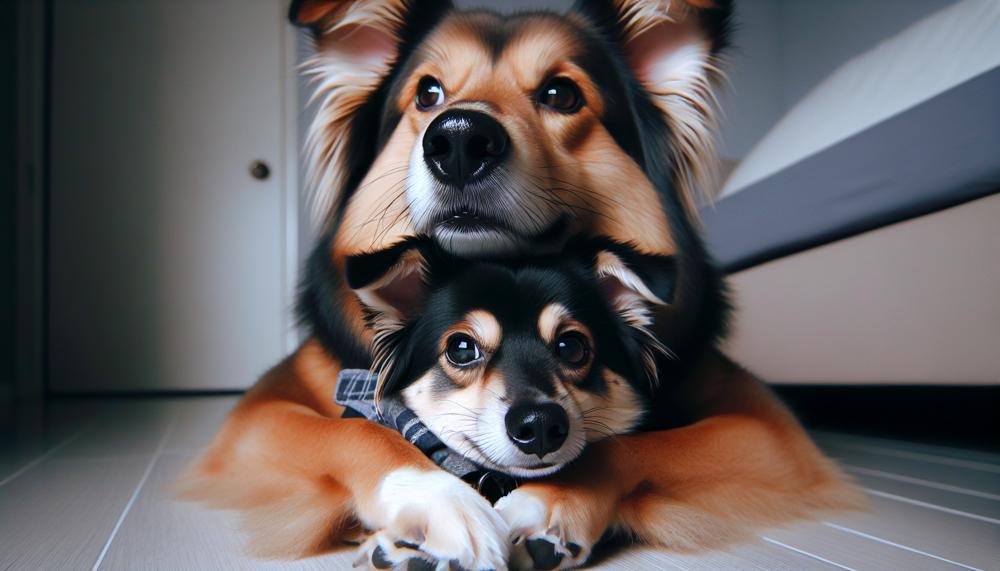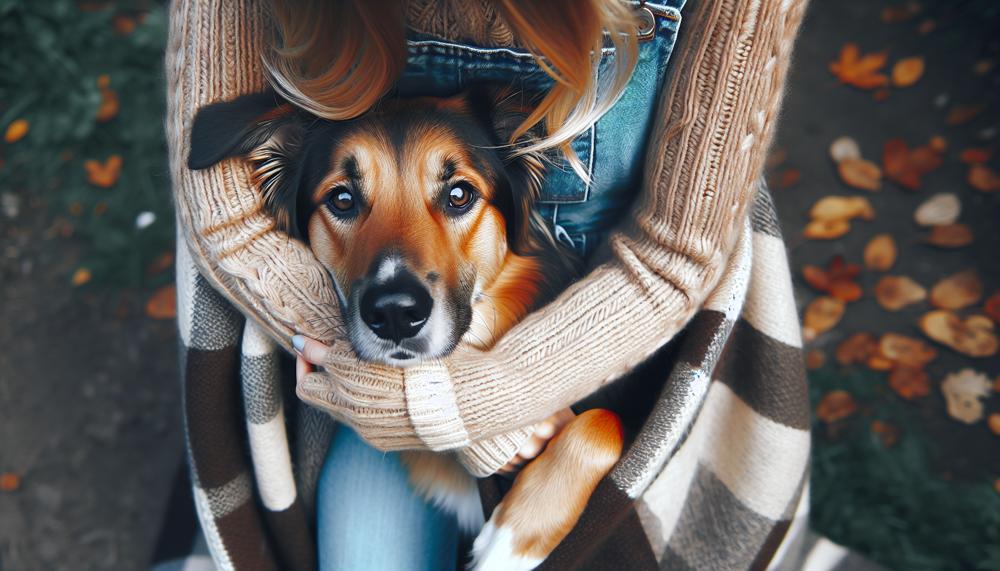Have you ever had your furry best friend suddenly become a shadow, following you everywhere and refusing to leave your side?
As a dog owner, I’ve always appreciated my pup’s independent nature, but recently he’s been sticking to me like velcro. And let me tell you, it’s been quite the journey.
So why is my dog so clingy all of a sudden?
A veterinarian is best able to assess concerns about your pet’s health. If you need immediate assistance, please call poison control or an emergency vet.
Here are some reasons why your dog might be clingy:
- Separation anxiety: Changes that limit your dog’s time with you or disrupt their routine can trigger separation anxiety. This can include recent moves, household changes, or changes in work schedules.
- Health problems: Some dogs become clingy when they’re in pain, or when they’re sick and want to be close to their trusted companion for support.
- Fear and anxiety: Dogs might cling to you because they see you as their security and guardian against potential threats. This is even more likely if your dog is naturally highly-strung or prone to anxiety.
- Boredom: If your dog is extra clingy when you return home, this might indicate that they are not getting the enrichment and attention they need from their caregiver when you are away.
- In heat: Female dogs can become clingy when they go into heat. This period is defined as the time leading up to your dog’s menstruation period.
Why is my dog being clingy? 6 Causes
Table of Contents
There are several potential reasons for a dog to suddenly become clingy towards their owner.
These include separation anxiety, functional changes in old age, being a “velcro dog”, past trauma, health issues, moving to a new place, jealousy towards other pets or new family members, lack of outdoor activities, and neglect from the owner.
| Cause | Description |
|---|---|
| Separation Anxiety | Separation anxiety is a common cause of clinginess in dogs. This occurs when a dog becomes distressed when their owner is not around, which can be triggered by traumatic experiences or illnesses. Signs of separation anxiety include following, whining, and increased clinginess when the owner leaves. |
| Functional Changes in Old Age | As dogs get older, they may experience physical or sensory changes that make them more reliant on their owners for guidance and comfort. This can result in them becoming more clingy as they seek out their owner for reassurance. |
| Velcro Dog | Some dogs have a natural tendency to stick close to their owners and seek attention and affection. This is known as being a “velcro dog” and does not involve anxiety when left alone. These types of dogs simply enjoy being in close proximity to their owner and receiving attention. |
| Past Trauma | Dogs who have experienced past trauma may become clingy as a way to cope with fear and seek comfort from their owners. This can be seen as a coping mechanism for dealing with previous traumatic experiences. |
| Health Issues | Underlying health conditions such as pain or illness can cause a dog to become clingy towards their owner for support and comfort. If your dog is experiencing any physical discomfort, they may turn to their owner for help in finding relief. |
| Moving to a New Place | Changing environments can be overwhelming for dogs and may cause them to become clingy as they adjust to unfamiliar surroundings. In this case, they seek reassurance from their owner as a source of comfort and security. |
| Jealousy | Introducing new pets or family members into the household can cause a dog to become clingy towards their owner out of jealousy and a need for attention. They may feel as though their territory is being invaded and act out in an attempt to regain their owner’s attention. |
What’s the difference between clingy VS velcro dogs?
When it comes to clingy and velcro dogs, there are subtle differences between the two that may help you determine which category your dog falls into.
Take a look at these key factors that can help you distinguish between the two:
| Signs | Clingy Dog | Velcro Dog |
| Following Owner Around | May follow with a sense of urgency, whining or pawing for attention | Follows calmly, may even lie down nearby |
| Reactions When Owner Leaves | Panics and may exhibit destructive behaviors | May whine or bark, but will usually calm down quickly |
| Preference for Being Close to Owner | Might prefer to sit on laps or be held constantly | Wants to be near owner but is content with just being in the same room |
| Training and Independence | May have difficulty being left alone or become easily anxious when not around owner | Can handle being alone for short periods and is generally more independent |
| Breed Tendencies | Not necessarily breed-specific, but smaller lap dogs and working breeds may be more prone to clinginess due to their breeding history and need for constant attention. | Naturally seeks attention and affection from their owner, regardless of breed. |
| Possible Underlying Causes | Past trauma, separation anxiety, health issues, or changes in environment or family dynamics may contribute to clingy behavior. | Positive reinforcement, breed tendencies, aging-related changes, or stress and anxiety may lead to velcro dog syndrome. |
If your dog’s clinginess is starting to become problematic, it’s important to address the issue before it escalates. This can be done through proper training and providing both mental and physical stimulation for your furry friend.
Also, if your dog shows signs of separation anxiety, it’s crucial to seek professional help from a veterinarian or animal behaviorist.
6 Solution to get your personal space back
Dogs can be highly independent creatures, but when they suddenly become clingy it can be overwhelming and frustrating. However, there are effective solutions to address this behavior and regain your personal space.
Below are six solutions that can help you understand and overcome clinginess in your dog.
Distinguish clinginess from separation anxiety:
Although often confused, clinginess and separation anxiety are two distinct behaviors. While clinginess can be addressed with training and stimulation, separation anxiety may require professional help.
By understanding the difference, you can take the appropriate approach in addressing your dog’s behavior.
Keep your dog mentally stimulated:
Boredom can be a major factor in clinginess. Make sure your dog is mentally stimulated with plenty of toys and activities while you’re away.
This will reduce their need for constant attention and combat boredom.
Provide comfort and support for elderly dogs:
As dogs age, they may become more dependent on their owners. This is especially true for dogs with canine dementia.
Offering them comfort and support can help alleviate clinginess and make them feel secure.
Address any underlying health issues:
Clinginess can also indicate underlying health problems.
If your dog’s clinginess is accompanied by other physical symptoms, it’s important to take them to the vet to rule out any potential health issues.
Maintain stability during major life changes:
Major life changes, such as moving or adding a new family member, can cause stress and anxiety in dogs, leading to clingy behavior.
To help your dog feel more secure, maintain routine and stability during these changes.

Consider the effects of a female dog’s ovulation cycle:
Female dogs may exhibit more clingy behavior during their ovulation cycle, which can last up to three weeks.
Is it okay to stop my dog from being clingy?
It is completely fine and even beneficial to teach your dog to be less clingy. This can improve their behavior and independence in the long run. Below are some tips on how to train your dog to be less clingy:
- Exercise their mental and physical abilities: One of the most effective ways to reduce clinginess in dogs is to provide them with enough mental and physical stimulation. This helps tire them out and keep them occupied, making them less likely to constantly seek attention from their owners.
- Avoid harsh reactions: When your dog is feeling anxious or clingy, it’s important not to react harshly. This could only worsen the situation and cause more anxiety in your dog.
- Use rewards: Motivation is key when it comes to training dogs. Use toys or treats as incentives for good behavior and gradually decrease their dependence on you.
- Create a comfortable space: Giving your dog a designated area where they can feel at ease and confident being alone can help reduce their clinginess. This could be a bed or crate where they can retreat to when they need some alone time.
- Consult with your vet: Sometimes, a dog’s clinginess can be caused by underlying health issues such as pain or discomfort. It’s important to consult with your veterinarian to address any potential health concerns that may be contributing to your dog’s clinginess.
- Gradually increase separation: Just like humans, dogs also need to learn how to be independent. Begin by gradually increasing the time your dog spends away from you, using doors, baby gates, or other barriers to help them adjust.
Also Read: Why Does My Dog Bring Me Toys?
Conclusion
In conclusion, the sudden clinginess of a dog can be a perplexing and frustrating behavior for owners.
However, after delving into the possible reasons behind this behavior, such as separation anxiety, past trauma, or changes in their environment, it becomes clear that there are various factors at play. These factors can contribute to a dog’s sudden need for constant attention and affection.
By gaining an understanding of the difference between clingy and velcro dogs and implementing effective solutions like mental stimulation, addressing health issues, and gradually increasing separation, owners can help their furry companions become less dependent and more independent. It is crucial to remember that every dog is unique and may require different training methods to overcome clinginess.
With patience and proper understanding, both owners and their canine friends can enjoy a happy and fulfilling relationship while also respecting each other’s personal space.






